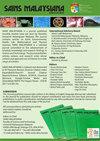不同烧成温度和稻壳灰分掺量下饮用水污泥发育砖的力学特性
IF 0.7
4区 综合性期刊
Q3 MULTIDISCIPLINARY SCIENCES
引用次数: 0
摘要
人们对利用废料制造替代砖很感兴趣。烧成温度大大提高了砖的机械质量。研究了烧制温度和稻壳灰分含量对饮用水污泥砖(DWS)力学性能的影响。生产了两种类型的砖;100% DWS砖(DWS100)和80% DWS和20% RHA砖(DWS80)。这些样品经受300°C和700°C的不同温度变化3小时。并制备了未烧结砖样品供参考。DWS100砖的体积变化随着烧成温度的升高而增大,在700℃时减小。DWS80砖也表现出类似的行为,但它在500°C的较早温度下收缩。在500°C和700°C时,砖的密度急剧下降,DWS80砖的密度始终小于DWS100砖。随着烧成温度的升高,DWS80砖的吸水率在低于DWS100砖的500℃时开始下降。添加rhaa的砖(DWS80)预计比DWS100砖吸收更多的水,但这并没有发生。这可能是由于粘土矿物结构的收缩,而不是在高温下有机物本身的去除。抗压强度随温度升高而升高。可以推断,尽管较高的火灾温度会显著提高添加了RHA的砖的强度,但RHA会降低砖的抗压强度。本文章由计算机程序翻译,如有差异,请以英文原文为准。
Mechanical Characteristics of Developed Brick from Drinking Water Sludge Under Different Firing Temperatures and Rice Husk Ash Contents
There is a considerable interest in making alternative bricks using wastes. Firing temperature has been significantly improved the mechanical qualities of bricks. The aim of this study was to investigate into the impact of firing temperature and rice husk ash content on the mechanical properties of drinking water sludge bricks (DWS). Two types of bricks were produced; bricks made of 100% DWS (DWS100) and bricks with 80% DWS and 20% RHA (DWS80). These samples were subjected to different thermal variations of 300 °C and 700 °C for three hours. The unfired brick samples were also prepared for reference. The volume changes of the DWS100 bricks increased as the firing temperature climbed up to 500 °C, before dropped at 700 °C. A similar behaviour was also exhibited by DWS80 bricks, however it shrunk at earlier temperature of 500 °C. At 500 °C and 700 °C, the density of bricks decreased dramatically, with DWS80 bricks consistently being lesser than DWS100 bricks. The water absorption of DWS80 brick began to decrease at 500 °C, a lower temperature than that of DWS100, as the firing temperature climbed. RHA-added bricks (DWS80) were anticipated to absorb more water than DWS100 bricks, but this did not occur. This presumably induced by the constriction of clay mineral structure rather than organic matter removal at high temperature per se. The compressive strength increased with the increase in temperature. It can be inferred that RHA can decrease the compressive strength of RHA-added bricks, despite the fact that a higher fire temperature significantly increased their strength.
求助全文
通过发布文献求助,成功后即可免费获取论文全文。
去求助
来源期刊

Sains Malaysiana
MULTIDISCIPLINARY SCIENCES-
CiteScore
1.60
自引率
12.50%
发文量
196
审稿时长
3-6 weeks
期刊介绍:
Sains Malaysiana is a refereed journal committed to the advancement of scholarly knowledge and research findings of the several branches of science and technology. It contains articles on Earth Sciences, Health Sciences, Life Sciences, Mathematical Sciences and Physical Sciences. The journal publishes articles, reviews, and research notes whose content and approach are of interest to a wide range of scholars. Sains Malaysiana is published by the UKM Press an its autonomous Editorial Board are drawn from the Faculty of Science and Technology, Universiti Kebangsaan Malaysia. In addition, distinguished scholars from local and foreign universities are appointed to serve as advisory board members and referees.
 求助内容:
求助内容: 应助结果提醒方式:
应助结果提醒方式:


